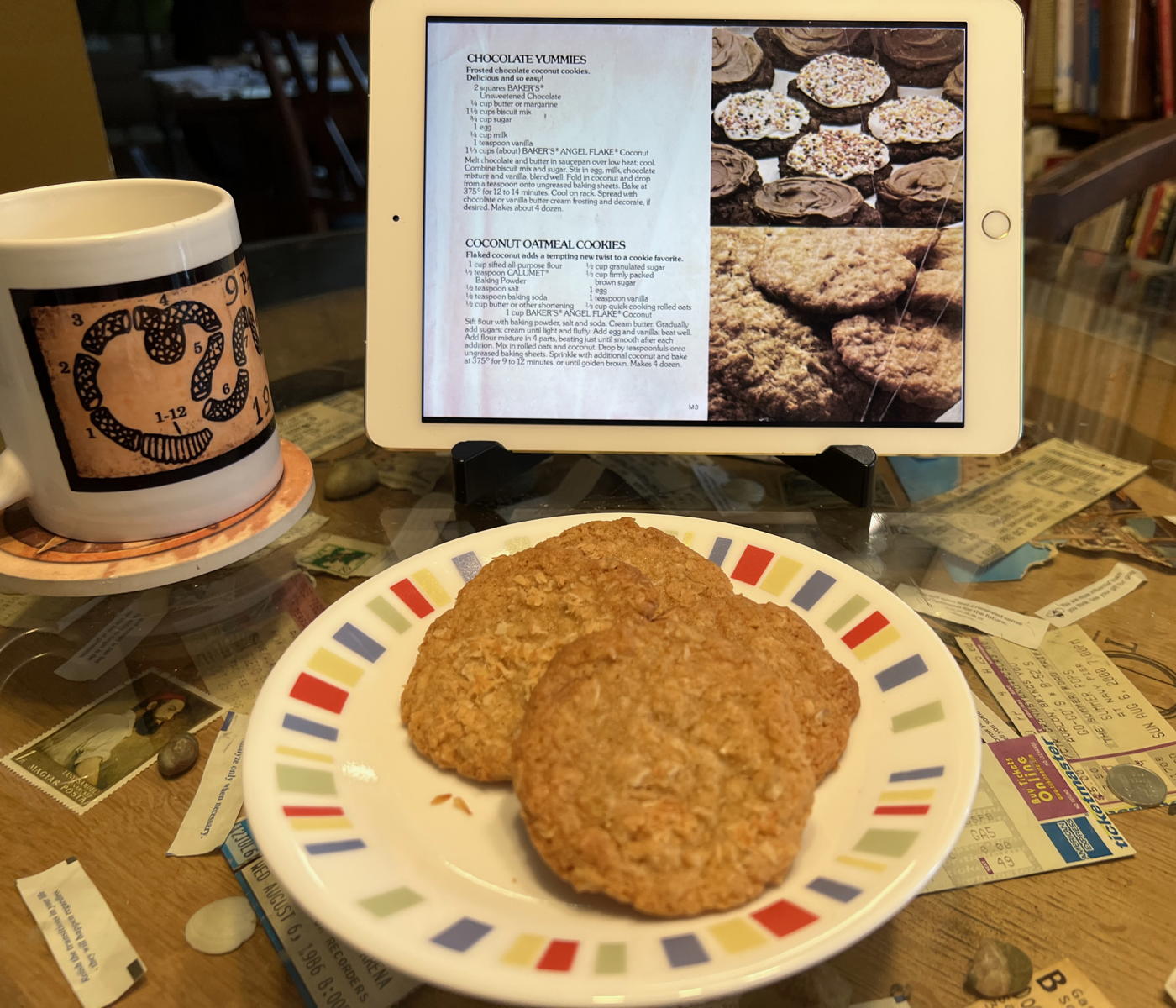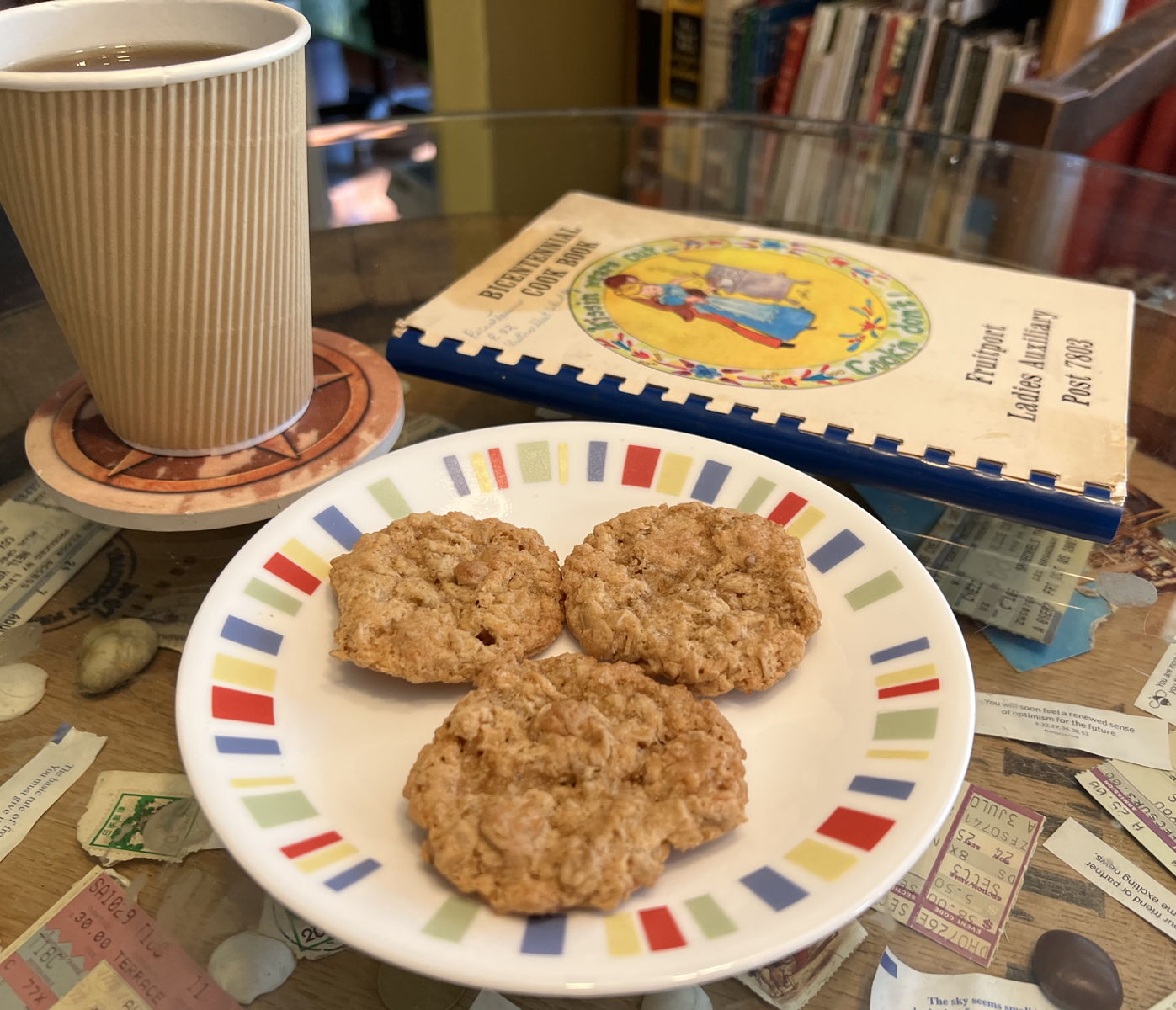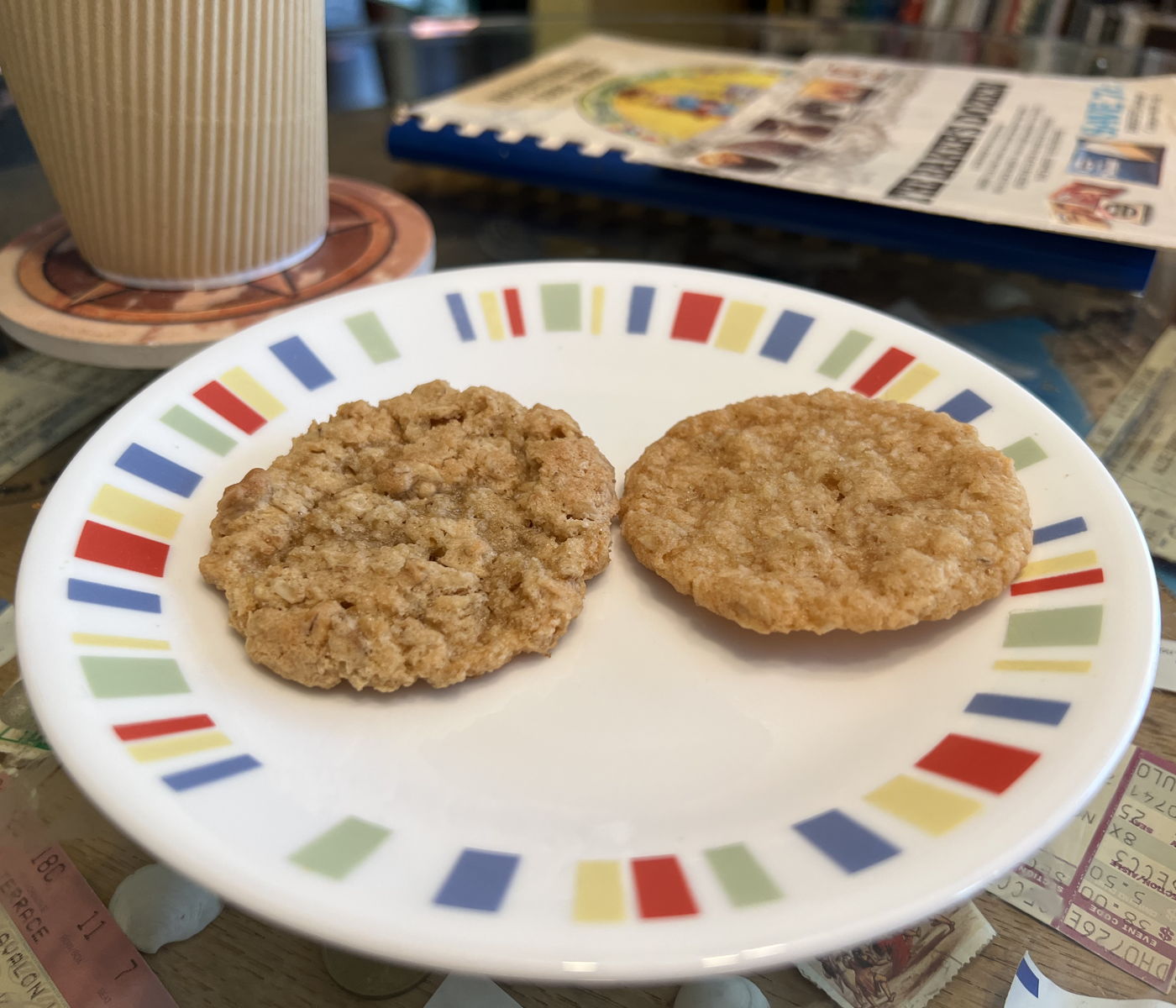Baker’s Dozen Coconut Oatmeal Cookies
A PDF of The Baker’s Dozen.
I said in the first installment that I’d have more recipes later from The Baker’s Dozen (PDF File, 3.3 MB). Here’s the first. I’m a huge fan of oatmeal cookies, so I couldn’t resist trying this recipe. They’re a wonderfully chewy-crunchy oatmeal cookie that flattens naturally into even rounds. The coconut enhances the chewiness without harming the crunchiness. If you sprinkle coconut on the cookies before baking, there’s a wonderful rush of toasted coconut flavor; if you don’t, the coconut flavor is much more subtle but the coconut chewiness remains upfront.
They’re great either way.
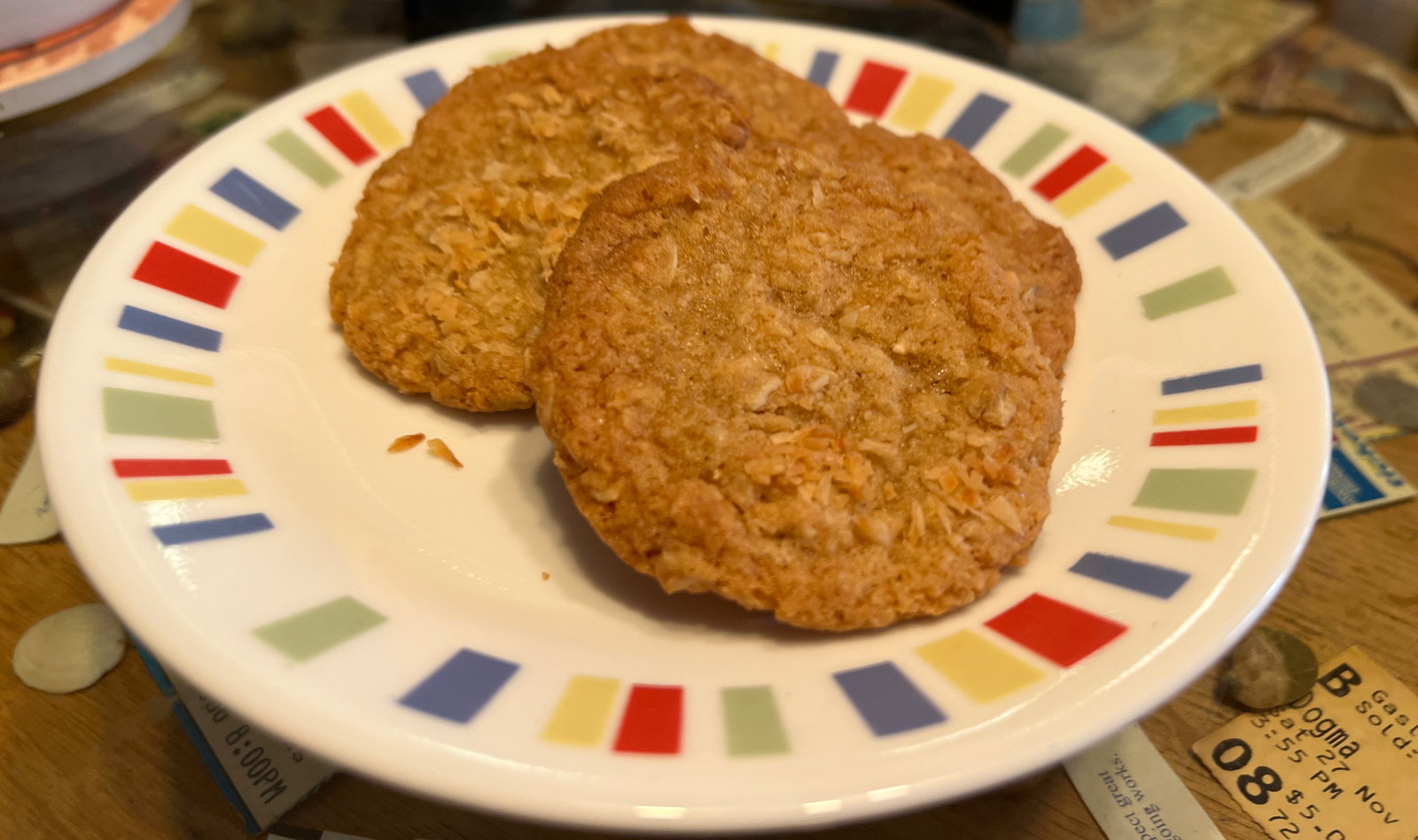
Baker’s Coconut Oatmeal Cookies
Servings: 48
Preparation Time: 30 minutes
The Baker’s Dozen (PDF File, 3.3 MB)
Ingredients
- 1 cup sifted all-purpose flour
- ½ tsp Calumet Baking Powder
- ½ tsp salt
- ½ tsp baking soda
- ½ cup butter
- ½ cup granulated sugar
- ½ cup firmly packed brown sugar
- 1 egg
- 1 tsp vanilla
- ½ cup quick-cooking rolled oats
- 1 cup Baker’s Angel Flake Coconut
Steps
- Sift flour with baking powder, salt, and soda.
- Cream butter.
- Gradually add sugars; cream until light and fluffy.
- Add egg and vanilla; beat well.
- Add flour mixture in 4 parts, beating just until smooth after each addition.
- Mix in rolled oats and coconut.
- Drop by teaspoonfuls (½ oz) onto ungreased baking sheets.
- Top each cookie with additional coconut if desired.
- Bake at 375° for 9 to 12 minutes, or until golden brown.
Because I’m a fan of oatmeal cookies, I keep track of such recipes, especially in my community cookbooks. There’s a very similar recipe in Fruitport, Michigan’s 1975 Bicentennial Cook Book. They use exactly the same ingredients (minus the Baker’s branding) but in very different amounts. That’s fascinating to me. What does the difference do?
For the Fruitport version you would reduce the flour to ½ cup, the soda to ¼ teaspoon, the butter to 6 tablespoons (from 8 tablespoons—½ cup is 8 tablespoons), the sugar to ¼ cup, the vanilla to ½ tsp, and the coconut to ½ cup. Increase the brown sugar to ¾ cup and the oatmeal to 1-¼ cup. That’s a lot more oatmeal with a lot less flour, and it makes only slightly fewer ½ ounce cookies. In my experience, it makes about 42-44 cookies instead of the 48 of the Baker’s Dozen version.1
You might also consider doubling the recipe so that the flour amount remains the same but the eggs, brown sugar, and oatmeal vastly increase. If you do double the recipe, as I’ve done here, you’ve got it as it originally appeared in the Fruitport Bicentennial Cook Book. It then makes a lot more cookies (probably because it’s meant for a hungry family of growing kids).
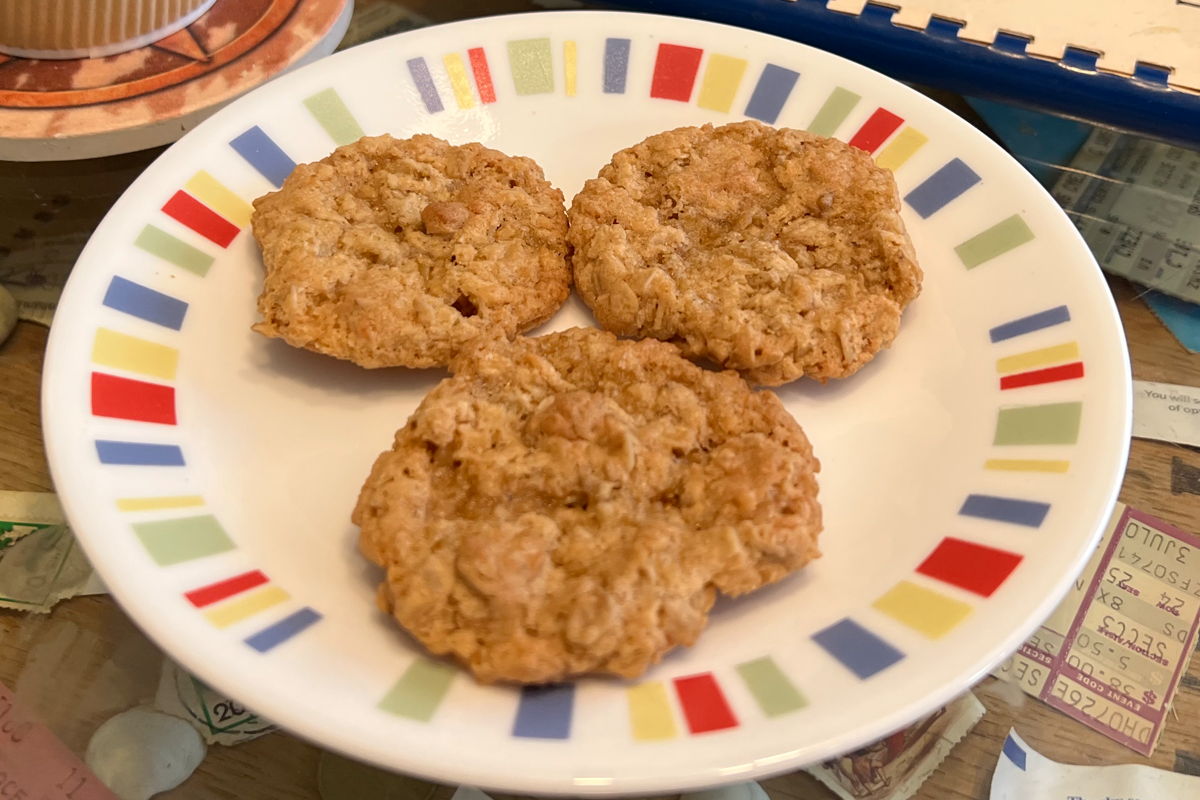
Fruitport Coconut Oatmeal Cookies
Servings: 84
Preparation Time: 30 minutes
Phyllis Loughmiller (Muskegon Heights, Michigan)
Review: Bicentennial Cook Book, Fruitport Ladies Auxiliary Post 7803 (Jerry@Goodreads)
Ingredients
- 1 cup flour
- 1 tsp baking powder
- 1 tsp salt
- ½ tsp baking soda
- ¾ cup soft butter
- ½ cup granulated sugar
- 1½ cup light brown sugar
- 2 eggs
- 1 tsp vanilla
- 2½ cup rolled oats
- 1 cup coconut
Steps
- Cream butter and sugar.
- Beat in eggs, one at a time.
- Add dry ingredients, vanilla, oats and coconut.
- Drop by teaspoons (½ oz) on ungreased baking sheet.
- Bake 10 minutes at 375°.
The Fruitport version doesn’t necessarily really double the recipe, depending on how you look at it. It still uses the same amount of flour2 and coconut, as well as the same amount of baking soda and vanilla. If you view both recipes as the same, the Fruitport version uses a lot more sugar, butter, eggs, and oatmeal. Mainly oatmeal: the Fruitport version has five times as much oatmeal as the Baker’s version. There’s no mention of sprinkling coconut over the cookies before baking, either.
The Fruitport recipe thus emphasizes the oatmeal rather than the coconut. Of course, Baker’s makes coconut, not oatmeal, so it’s not surprising that they’d switch the emphasis around.
Both of these publications came out right about the same time. The Baker’s Coconut pamphlet is dated 1976, and the Fruitport Bicentennial is dated 1975 but obviously targeted the bicentennial in 1976. It’s likely that that’s when they expected to sell most of their copies.3
Both variations are great. I probably prefer the Fruitport version. More molasses and oatmeal, less flour and coconut per cookie. It’s slightly crunchier on the outside while remaining chewy on the inside. It had, in fact, more of an inside. The Fruitport version doesn’t form perfect flat rounds the way the Baker’s version does. I was amazed at how perfectly disc-shaped the “commercial” versions turned out. This is likely because of the higher ratio of oatmeal to flour in the Fruitport version.
The Fruitport version was far more addictive, too, probably because of the higher ratio of sugar to flour.
When I started this test, I expected to add only one of the recipes to my rotation. One was clearly going to be better than the other. In fact, they’re different enough that I can’t decide, which means they both go in. If this were 2026 and I were making the decision on which version to include on the Padgett Sunday Supper Club, however, I’m pretty sure it would be the Fruitport version. I do like oatmeal.
Interestingly, and apropos of nothing, I discovered that if you let the dough sit for a while, the cookies don’t flatten nearly as much when baking. When I made the Fruitport version I underestimated the time it would take, and I needed to be somewhere. I let the unbaked cookies sit, ready to go into the oven, for an hour while I was out. I baked them as soon as I returned, and they stayed as sort of rock-like shapes, mounded and uneven around the edges.
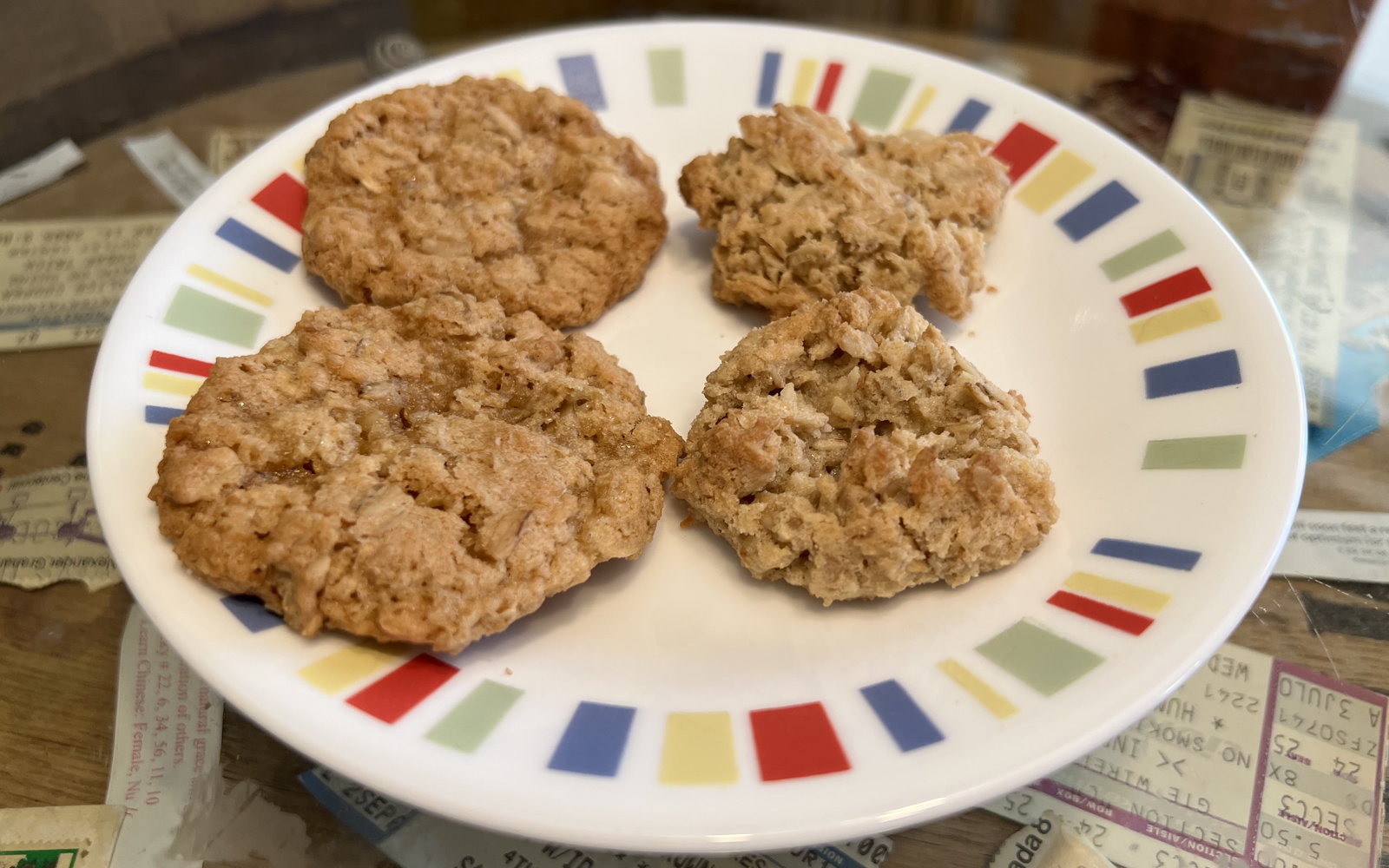
I let one batch of the Fruitport version sit for an hour on the counter, unbaked, before putting it in the oven (well, one hour plus the time it took to preheat the oven). They did not spread nearly as much as the ones that went in “fresh”.
The flavor and even the texture is the same. They just didn’t spread as much. If, as Giada deLaurentiis says, we eat with our eyes first4, you definitely don’t want to let them sit too long before baking.
One more thing: I now have The Baker’s Dozen scanned for download as a PDF file (PDF File, 3.3 MB). You might consider one or both of these cookies for your Thanksgiving celebrations!
In response to Three from the Baker’s Dozen: Three recipes from a Baker’s Coconut pamphlet once included in McCall’s magazine: coconut squares, chocolate cheesecake, and broiled coconut topping.
The Fruitport version made 41 cookies when I made it with this halved recipe. There was definitely enough leftover at the end for one more cookie, but rather than bake a single cookie I just ate the raw dough (both of these recipes make great raw doughs). I also ate a bit of the dough while spooning out the cookies onto the cookie sheet. I don’t know how much, but probably one or two cookie’s worth.
↑Technically, the Fruitport recipe uses slightly more flour. The Baker’s Dozen recipe calls for sifted flour and the Fruitport recipe does not. For one cup, that’s a difference of 0.8 ounces—5.0 for unsifted, 4.2 for sifted. At least in my experience, but those are the numbers I used for this recipe; when using a stand mixer I almost always measure flour by weight into a mixing bowl, then whisk in the other dry ingredients.
↑Which shows some serious planning on their part, uncharacteristic of community cookbooks. I’m slightly surprised, now that I think about it, that I have never run across a bicentennial community cookbook from 1977 or 1978.
↑I eat with my eyes first. — Giada De Laurentiis (Calabrian Chile Pasta)
↑
- The Baker’s Dozen (PDF File, 3.3 MB)
- A 1976 baking pamphlet from General Foods and Baker’s Coconut, in McCall’s magazine. Focused on coconut and chocolate.
- Padgett Sunday Supper Club
- Dedicated to the preservation of vintage recipes.
- Review: Bicentennial Cook Book, Fruitport Ladies Auxiliary Post 7803: Jerry Stratton at Jerry@Goodreads
- Bread and butter pickles, barbecued franks and beans, creamy orange salad—this Fruitport, Michigan bicentennial cookbook is filled with homey recipes.
More Baker’s Coconut
- Three from the Baker’s Dozen
- Three recipes from a Baker’s Coconut pamphlet once included in McCall’s magazine: coconut squares, chocolate cheesecake, and broiled coconut topping.
More coconut
- Three from the Baker’s Dozen
- Three recipes from a Baker’s Coconut pamphlet once included in McCall’s magazine: coconut squares, chocolate cheesecake, and broiled coconut topping.
- Bicentennial Pie for Pi Day
- A pie and crust from 1976 for Pi Day. The crust is a coconut crust, and the pie is a whipped orange-gelatin filling. Top it all off with chopped macadamia nuts and you’ve got a pie fit for any holiday.
- Cream of coconut jack-o-lantern soup
- If last year’s jack-o-lantern soup wasn’t gruesome enough, try mixing your pumpkin’s disgouged facial parts with coconut and ginger.
More cookies
- Jalapeño Potato Chip Cookies
- Potato chip cookies are amazing—crunchy and flavorful—and they’re even better made with kettle-style jalapeño chips! Potato chip cookies are a great way to celebrate National Potato Day.
- Candy cane oatmeal crispies
- These candy cane cookies are a great way to use up post-Christmas candy canes. You might even want to hit the after-Christmas sales just to get canes to make these with.
- Pie crust cookies
- I see I’m not the only one to come up with this basic idea; it seems obvious in retrospect.
- Chocolate cookies (for breakfast)
- We woke up this morning and then we stayed in bed for a few hours. And when we finally did get up, we desperately needed breakfast. And sugar. And chocolate. What we needed were chocolate cookies for breakfast. Made quickly with a minimum of fuss.
- Half-hour lemon cookies
- Half-hour cookies can be made with lemon juice instead of vanilla.
- Three more pages with the topic cookies, and other related pages
More oatmeal
- Candy cane oatmeal crispies
- These candy cane cookies are a great way to use up post-Christmas candy canes. You might even want to hit the after-Christmas sales just to get canes to make these with.

